If you didn't get this, you should see it. It may be personalization run amok, but it's always nice to be thanked!
http://my.barackobama.com/
There is one particularly interesting thing about it. They are pushing sharing, but they appear to have controlled it carefully. I tried sending it to BlogReaders--I thought that would be a nice touch; when that didn't work, I used the word Reader, hoping it would recognize that as a given name. No luck--in both cases, it came back personalized to Friend. When I send it to Robert, it recognized a real name and personalized. Nice filter! Don't give them credit for thinking this up, however. In March 2008 I wrote about a video sent to a student during the Dutch political campaign. Not as elaborate, but perhaps a bit funnier. Last fall another student ran the (winning) campaign for the Conservative Party in Norway using a lot of electronic and social media.
Don't give them credit for thinking this up, however. In March 2008 I wrote about a video sent to a student during the Dutch political campaign. Not as elaborate, but perhaps a bit funnier. Last fall another student ran the (winning) campaign for the Conservative Party in Norway using a lot of electronic and social media.
The key is that both countries have election laws that permit only a minimal amount of money to be spent (and a short time in which to spend it). What a good idea! Wish I believed it could ever happen here!!!
I'll see you early in the new year. Let me add my wishes to those of the famous friend for a wonderful holiday season for all!!!
Monday, December 21, 2009
Personalized Email From "A Friend"
Posted by MaryLou Roberts at 10:48 AM 0 comments
Labels: new media, personalization, social media, social media strategy
Friday, December 18, 2009
Ghost of Christmas Future?
It’s no secret that I think apps are the future, and we can see it emerging now. However, I’m not a big mall shopper, so I haven’t experimented with shopping apps for my iPhone except for a grocery list, which I quickly became unable to live without. My students are on the same wave length. In fact, last night one tried to convince the class that we wanted to listen to sports events on our smart phones! No sale there, Laura! but I was thinking about apps when I saw this article in the NYT today. The idea of mobile phones as an essential tool for shopping intrigues me, although it may strike fear into the hearts of some retailers.
The video is fascinating, so I decided to experiment. I downloaded the free ShopSavvy app with no trouble. However, it didn’t work. Ok, go read some more. I found out that it only works on the iPhone 3Gs. Reason: older iPhones lack the autofocus function that makes a bar code readable.
Is there a bar code scanner app for the 3G? Yes, I found RedLaser and it looked pretty good. I downloaded that, although along the way I had to update my iPhone software; that took longer than the two app downloads together. After that, $1.99 and a few seconds later, I had a bar code scanner.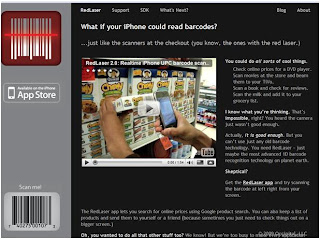 First thing I tried was a Diet Coke can. The UPC is on the side, so the can kept rolling around and getting glare from the metal; never did get it to work. However, I pointed the scanner at the bar code on the RedLaser site, and moments later I had lift off! The code is for a snuggles blanket and it sells for as little as $11.99 online and shows $14.99 at both Best Buy and Sears, which are near me. And I didn’t need to try to integrate it with the ShopSavvy app; it gave me results from Google search and from the Find. Fascinating!
First thing I tried was a Diet Coke can. The UPC is on the side, so the can kept rolling around and getting glare from the metal; never did get it to work. However, I pointed the scanner at the bar code on the RedLaser site, and moments later I had lift off! The code is for a snuggles blanket and it sells for as little as $11.99 online and shows $14.99 at both Best Buy and Sears, which are near me. And I didn’t need to try to integrate it with the ShopSavvy app; it gave me results from Google search and from the Find. Fascinating!
Thank goodness I’ve finished my Christmas shopping, but I decided to check how well I did on one item. The hard drive I bought sells for as little as $109.95 online and as much as $179.99 at retail outlets and some online merchants. So I did just fine—thanks to a sale and loyal customer discount at Staples! Are you surprised at the price range? I was! Of course, customers will think about shipping when they see the online prices. Does this kind of shopping confirm the wisdom of all the free shipping offers we are seeing this holiday season?
This is all pretty new, and not that many shoppers are yet using it. What about next Christmas? Fearless Roberts prediction; this is going to catch on fast. Corollary to that; if I can do it, anyone else with a smart phone can!
Retailers, both online and off, seem to have two choices. They can offer to meet the lowest price; notice that Wal-Mart’s price matching offer (current TV ad appears to simply restate the policy on their site) excludes online prices. That obviously can cut into a retailer’s margin—and what if it’s counter to the merchandising strategy?
I would describe the second option as, “you can’t beat them, so join them.” I’ve previously described apps intended to make it easier to shop at certain stores or buy certain brands. That is going to make sense, at least for first movers for awhile. Like everything else, however, there will be a limit to how many apps customers want.
Is this within range of small local retailers? I searched again and found this site; the costs are consistent with what I’ve seen before and on the low end are not excessive.
Should retailers—large and small—be thinking right now about next Christmas and how they can take advantage of the trend to mobile-assisted shopping?
Posted by MaryLou Roberts at 1:22 PM 0 comments
Labels: location-based marketing, mobile, mobile marketing, mobile shopping, social applications
Thursday, December 17, 2009
Repower America's Video Wall
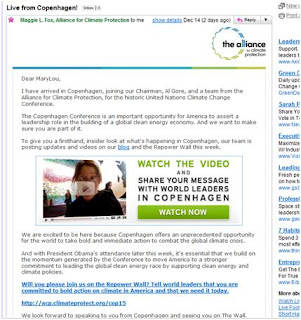 As the climate summit began in Copenhagen I received this email from Repower America. While none of the supporting activities are strikingly new, some of them are interesting.
As the climate summit began in Copenhagen I received this email from Repower America. While none of the supporting activities are strikingly new, some of them are interesting.
Their communications in and from Copenhagen center around a wall created just for the purpose. It’s worth either watching the video or going directly there. Videos on walls are nothing new; a video wall is new to me. So much for the technology. The content blends contributions from corporate promoters of efforts to halt climate change with the submissions of well-known people in the field and of the general public. That alone is interesting. The corporate activists are interesting; some are acting in terms of their mission, some clearly in self interest, and others were something of a surprise to me. You can mouse-over the wall and see for yourself.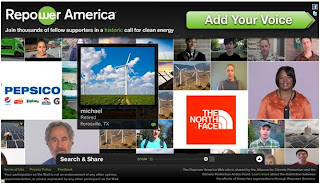 It took effort to get the wall up and provisioned with a credible number of videos in just a month. I’m sure that they did a lot of reach out; here’s how some of it went in the blogosphere.
It took effort to get the wall up and provisioned with a credible number of videos in just a month. I’m sure that they did a lot of reach out; here’s how some of it went in the blogosphere.
This is a little different from the usual cause-related marketing in which one corporate sponsor usually plays a leading role, whether or not there are multiple sponsors. I was going to use Komen Race for the cure as a good example; I see they’ve gone beyond a single major sponsor plus many lesser sponsorships. Their sponsorship page is fascinating. It links to a page with 5 questions corporations should ask when considering cause sponsorship. The questions are excellent; they provide a useful framework for non-profits that are considering a major sponsorship push.
I’ll make the point again. Cause-related marketing not only is a heavy user of social media, it is part and parcel of social media strategy. Corporations are searching for ways to relate to and engage customers and potential customers in a way that does not mimic the intrusiveness of traditional media advertising. Cause-related marketing presents one superb solution, aligning the corporation with a worthwhile cause and providing visibility and support for the cause. Everybody wins!
Posted by MaryLou Roberts at 11:05 AM 0 comments
Labels: cause-related marketing, social media strategy, user generated content, video
Wednesday, December 16, 2009
Are Lawyers Going Social?
I was aware of the website LegalZoom through its TV ads featuring celebrity attorney Robert Shapiro. That was all until a student pointed out their other online activities, which I found quite unusual for a legal firm—thanks, Fiesal!
The current centerpiece of the online strategy is a contest, just concluded, that allows customers to upload videos about their experience with LegalZoom. Here’s their YouTube video. The embed looks like nothing special, but play it all the way through—the 40 seconds is worth what you find at the end. When the video finishes you get thumbnails of customer videos that have been submitted. I don’t know how to do that, but it’s very cool and it makes the point that people are entering the contest.
That brings me to my favorite question: how did they let customers know about it. I’ll bet there were outbound communications, through their corporate newsletter probably. I have visited the site several times recently, and I didn’t see a notice about the contest. It has its own separate website, which links back to the corporate site, but I don’t find anything on the corporate site that links to the contest site, although entries to the contest have been closed for five days now, giving them enough time to remove a notice. Given the care with which they do other things, and the fact they are lawyers, I doubt that is an accident. That guess is supported by the fact that the winners are not scheduled to be announced until December 20—5 days from now. CPG sites would be hyping the winner announcement.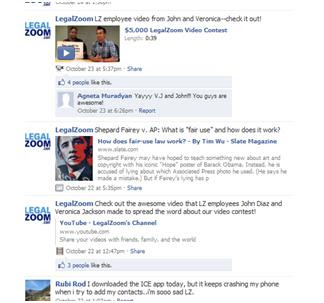 Ok, there is a separate website; you still have to get customers to that website. They have a very active Facebook page; I’d recommend it as a “best practices” business Facebook page. It’s active; there are a lot of informative links. They have only 1,197 fans at this point, but they used the Facebook page aggressively to promote the contest. The screen capture shows 2 posts announcing the contest. There were others throughout the contest. The last entry I saw was on December 7, promoting the last chance to vote on the contest.
Ok, there is a separate website; you still have to get customers to that website. They have a very active Facebook page; I’d recommend it as a “best practices” business Facebook page. It’s active; there are a lot of informative links. They have only 1,197 fans at this point, but they used the Facebook page aggressively to promote the contest. The screen capture shows 2 posts announcing the contest. There were others throughout the contest. The last entry I saw was on December 7, promoting the last chance to vote on the contest.
They do something else I love. Each week they welcome “New Zoomers;” new fans, presumably. How nice is that??? They also had Halloween picture contests. Perhaps most important, their strategy jumps out of the Facebook page at you; you can see it on the website, but it’s not as evident. Their primary segment is small businesses and they are providing all sorts of content and encouragement to them. Definitely best practices! They are also active on Twitter; I’m guessing there’s a feed between the two, but I didn’t take time to trace the posts/Tweets. In addition, a search turns up a lot of PR activity surrounding the contest.
Finally, I can guess how they got the idea for the contest. According to the website of their interactive agency, they have been using client testimonials in their advertising for at least a year. That shows a clear, sensible evolution of online strategy.
It would be a great integrated program for any large corporation. For what’s essentially a website-only business model for services, it is striking. For a group of lawyers it is simply mind-blowing!
Posted by MaryLou Roberts at 12:04 PM 0 comments
Labels: best practices, business models, Facebook, professional services marketing, social media strategy, Twitter
Tuesday, December 15, 2009
The Power of Customer Reviews
The e-tailing group and Power Reviews did an interesting study that was published in September—something else that has been sitting around on my desktop. An article in Ad Age (subscription may be required) on small marketers who were successfully using reviews to get their products noticed motivated me to get the report out and look at it again.
Here’s some of the data from the 117 retailers interviewed. They respondents were distributed over large and small firms and their perceptions are interesting. Here are some of the primary ones:
Retailers are most concerned that people will trash their products; don’t have much faith in their own business, do they? It’s interesting though that, when you combine Rank 1 and Rank 2, just about as many are concerned that customers will leave their site for a more socially engaging one. Even more are concerned that they are using outmoded marketing and merchandising techniques. Hear, hear!
Of course retailers want to sell things! But, according to these data, they also want to engage their customers, drive brand loyalty, and stimulate word of mouth. Those all make sense. They also point out that social media isn’t an immediate solution to any marketing issue. It is an investment of time and energy that pays off over time.
Which of the social media efforts are most effective, in increasing sales? Reviews; nothing else comes close. All retailers should ask themselves what they are doing to provide an opportunity for customers to review their products and experiences. What are they doing to encourage customers to provide those reviews?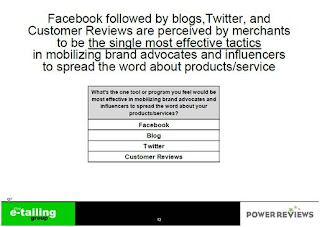
Which of the social media efforts are most effective in mobilizing advocates and spreading the word about their brand? Facebook! Reviews are at the bottom of the list and Twitter is next to the bottom. People do say that reviews influence their purchases; is that not spreading the word? I hope these retailers were paying attention to this year’s Black Friday/Cyber Monday Twitter efforts. The good news is that Twitter can have an immediate impact on sales. The bad news is that it takes time and effort to build a base of Twitter followers that permits impactful marketing. Bear in mind that it takes time and effort to build a following of Facebook friends also!
The Ad Age article gives examples of issues. Let me briefly tell the story:
• Shane Faerber is an individual developer who wrote an app, Mall Maps, for the competitive iPhone applications space (over 80,000 of them the last time I looked).
• When the app was launched he wrote the first review—with complete transparency. He said he was the developer, provided a video and invited feedback. He even put his email address in the app itself.
• He reached out to professional reviewers and media outlets, getting some positive notice and a ranking of 26 (out of about 18,000) in his category.
• Apple paid attention and on Tuesday before Black Friday named the Mall Maps a must-have. By Wednesday it had moved up to number 1 in its category. It was originally priced at $2.99. Today it’s on sale for $1.99 but I don’t see a current downloads stat.
Great as the success of the app is, that’s not what I found most impressive. Here’s the quote from Ad Age:
along the way, Mr. Faerber's hand turned a handful of dissatisfied customers into positive endorsers. One customer, whose initial review started with the opener: "SO FAR STINKS!" eventually wrote that he was "impressed with your customer service" and wished Mr. Faerber "the best of luck" after a series of e-mail exchanges with the developer.
What works?
• Reaching out to potential customers.
• Reaching out to the media, especially the online media for an online product.
• LISTENING to your customers. Even more, ENCOURAGING THEIR FEEDBACK!
Posted by MaryLou Roberts at 12:12 PM 0 comments
Labels: brand evangelists, brand loyalty, consumer engagement, consumer reviews, Facebook, social media strategy, Twitter
Friday, December 11, 2009
The Importance of Integration
I've been aware for quite some time that IBM was exploring the use of social media in various contexts. Today I listened to a webcast by Sandy Carter, Social Media Evangelist at IBM. The webcast has strategy, case histories, and advice on how to make social media initiatives work in an organization.
View the webcast here.
All those are very important subjects to the social media marketer. And the title makes the key point; marketers have to integrate social media into their overall marketing mix! Sandy Carter makes a strong argument for better results for existing marketing programs with the inclusion of social media component.
It's well worth the 40 minute duration of the webcast, now archived on BrightTalk.
Posted by MaryLou Roberts at 1:16 PM 0 comments
Labels: integrated marketing communications, marketer response to social media, marketing organization for new media, social media strategy
Wednesday, December 9, 2009
Communicating the U Wisconsin Snowball Fight
I don't usually do current event announcements, but this one is too good to pass up. Actually, I don't usually have The Weather Channel on for a long period of time but we're having an awful storm on Cape Cod--the kind where my yard furniture blows around and I listen to TWC to find out how far it might go and when it's safe to set it upright again.
The point is, however, that TWC knew that UWisconson Madison is closed today--a feed or manual monitoring, I don't know. However the local papers and broadcast outlets have picked it up also. Probably the first to know were students who quickly found out that their classes were canceled today!
A Facebook event page was quickly set up to announce a campus snowball fight at 2 p.m. I don't know what time the page was created but as of this writing about 1 p.m. EST, there are
- 5,482 confirmed guests
- 3,437 "maybe attending"
- 221 wall posts.
I made 2 screen captures, the first one something like an hour ago (I've been outdoors chasing yard furniture!). In that period of time the notice at the top of the posted image, **ESPN seeking videos" appeared. Ponder that!
I was already going to point out that this will be on the nightly news, and I wouldn't be surprised if CNN has it on live or at least has an Internet report before the event is over.

Note: While I was editing this someone from Madison located it! Wow!
Such is the power of instant, social-network-based communications!
Posted by MaryLou Roberts at 12:57 PM 0 comments
Labels: Facebook, social media, social networks
Monday, December 7, 2009
Contemporary Views on Business: Partnering for the Future

Contemporary Views on Business: Partnering for the Future" (Combi2010) is an important forum for knowledge co-creation and intellectual exchange emphasising partnering and international knowledge transfer as sources of competitive edge. In Combi2010, you are reserved plenty of time for lively dialogue, responsive thought transference and ideation.
Combi2010 joins the great minds of academics, business executives and other professionals from both private and public sectors to share and co-create knowledge on business-related topics. Furthermore, Combi2010 actively seeks to promote synergies between business and academia. Our international conference programme contains tailor-made modules to satisfy even the most demanding needs of faculty members, executives, entrepreneurs, and post-graduates.
Combi2010 is hosted by four Universities of Applied Sciences from the larger Metropolitan region (HAMK, Helsinki Metropolia, Laurea, LUAS) and being organised in collaboration with partners incl. e.g. ECR Finland, the Regional Organisation of Enterprises in Uusimaa and international scientific journals.
Calls for participation are open from 4 January 2010 onwards. Submit online at www.combi2010.fi your
· competitive paper manuscript not exceeding 20 double-spaced pages and/or
· poster presentation abstract of 1500-5000 characters and/or
· work-in-progress presentation abstract of 1500-5000 characters and/or
· special session proposals of not exceeding 5 double-spaced pages
See the Calls for the various types of submissions on this page.
Combi2010 has 19 Tracks representing the subject fields of Business Studies, Leadership and Entrepreneurship. Please consult the conference website for details. See the draft program, including keynote speakers here.
Best Paper in Conference will be awarded. All the accepted papers will be published in the printed, ISSN/ISBN identified, Conference Proceedings and in an electronic format on a USB drive. In addition to this, the best papers chosen by Track Chairs are eligible for publication as double blind peer reviewed articles at least in the International Journal of Technology Diffusion and International Journal of Management Innovation Systems. The Journal of Internet Banking and Commerce will publish a special issue on Combi2010 Conference Papers.
Keep your eye on the website for the latest developments.
The Calls close by the end of March 2010.
The Combi2010 Organising Committee awaits to see you in Finland next October!
Posted by MaryLou Roberts at 11:58 AM 0 comments
Labels: call for paper submissions, Combi2010, conference in Finland, conference in Vantaa, innovation
Friday, December 4, 2009
Does Behavioral Tracking Threaten Consumer Privacy?
According to a recent study by researchers at the Universities of Pennsylvania and California at Berkeley and sponsored by the Rose Foundation for Communities and the Environment, consumers think it does! Whatever marketers themselves think, these opinions threaten behavioral advertising, and we should take them seriously.
The New York Times had an excellent article when the report was published. It’s an important report, and I’d encourage you to use the link in the Times article and download it to read the entire thing. You will find careful methodology and a carefully chosen, if not huge, sample.
The findings are what’s most important, and here are two of the key ones:
• Even when they are told that the act of following them on websites will take place anonymously, Americans’ aversion to it remains: 68% “definitely” would not allow it, and 19% “probably” would not allow it.
• Americans mistakenly believe that current government laws restrict companies from selling wide-ranging data about them. When asked true-false questions about companies’ rights to share and sell information about their activities online and off, respondents on average answer only 1.5 of online laws and 1.7 of the 4 offline laws [questions] correctly because they falsely assume government regulations prohibit the sale of data. (pp. 3 & 4)
I think the incorrect beliefs about government regulations contribute to the aversion problem; it’s another instance of people feeling duped when they find out the truth. This is a societal problem, not a problem for any one business. Still, individual businesses can be open and honest about their own activities, building trust as they do so.
Both these issues are important but let me present just one chart on aversion to behavioral tracking with the two columns you need to compare highlighted.![]() First, note that the respondents are more willing to allow tracking when it produces discount offers they want. We’ve been seeing a lot lately about how intensively consumers are using the web to look for promotions and discounts, so that makes sense.
First, note that the respondents are more willing to allow tracking when it produces discount offers they want. We’ve been seeing a lot lately about how intensively consumers are using the web to look for promotions and discounts, so that makes sense.
Second, lower table, when the question includes specifics about the information used to tailor the ads, discounts and news, the percentage of people willing to accept goes down—a little less for discounts, but they all go down. Look further; when information is brought in from other websites (the essence of behavioral advertising) or from offline, the willingness to accept plummets.
The full report also had a breakdown by age segment. Younger people are more willing to accept the tailored offers than older ones, but there’s not as much difference as I expected. And younger people show the same pattern of being less willing to accept tailored offers when the source of information is specified.
This is disturbing to the Internet marketer, and there is no easy solution. There have been a few meager efforts by coalitions of businesses and trade groups to better inform users about the nature and benefits of collecting and using consumer data and the differences between anonymous and identified data. The efforts appear to have been half-hearted and it’s clear that they had little impact.
Worse, that’s the only real solution I can think of. Do you have any better ideas???
In the meantime, keep building your trusted brand!
Posted by MaryLou Roberts at 1:33 PM 0 comments
Labels: behavioral advertising, consumer data, consumer privacy, personalization, trust
Wednesday, December 2, 2009
Did You Get a Twitter Wake-Up Call?
Black Friday has been a retail shopping phenomenon, probably ever since shopping malls were invented. A few years ago, Cyber Monday joined the retail scene as an important online shopping day, although last year December 9 was actually the heaviest online shopping day of the year. This year, the lines seem to have blurred as the amount of online shopping continues to increase, stimulated by social media. Marketers are using social media to get shoppers revved up earlier, both in the stores and especially online.
I’ve written before about the importance of Twitter and Facebook to consumers who are looking for bargains. This year marketers took advantage of that to promote deals—sometimes on an hourly basis—on both days. The New York Times called it the "first Twitter Christmas” and has links to more examples of corporate marketing efforts. The Motley Fool has more.
Two examples:
• Penney is the one with the wake-up call—take your pick of a message from Cindy Crawford, Kimora Lee Simmons or Rascal Flatts. A wake-up call was needed; they started Tweeting special deals and coupons at 4 a.m. Black Friday morning. That’s good, but why do they have a Facebook link on their site but not a Twitter link? Worse, their Black Friday press release gave a twitter account link that doesn’t work. This annoying one does. http://twitter.com/JcPenney
• Best Buy has been pushing their TwelpForce since last summer, complete with television ads. I took a quick look around the blogosphere and there are some positive, some negative posts about its effectiveness, but Best Buy is clearly putting effort into it. It’s easy to find other customer service options from the Best Buy home page, but not TwelpForce.
Do you see a pattern here? The Twitter initiatives, especially for Christmas shopping, are important. Why are they so hard to find???
With apologies to an article I read over the Thanksgiving weekend and promptly lost, there’s a point beyond successfully integrating these social media efforts into the overall communications program. I’m not sure how Penney’s got the word out except for the zillions of Black Friday/Cyber Monday, coupons, and deals sites and blogs. Did they do some ads that included the Twitter deals? Perhaps; I didn’t see any. Best Buy used a significant amount of television to support the TwelpForce launch. These two firms are a small sample, but the skew is heavy in favor of Twitter and Facebook—non-paid media.
The article I read pointed out that newspapers stood to lose even more revenue as businesses come to understand effective uses of social media. Good for business, bad for newspapers. Today’s eMarketer newsletter quotes a study from The Center for Marketing Research at UMass Dartmouth that pointed out that “the Inc. 500, a list of the fastest-growing private companies in the US, is outpacing the larger, more traditional companies in the Fortune 500 in many social media activities.” (“Social Media Marketers Declare Success” December 2, 2009)
Could that be the biggest impact of social media on retailing in the long term? As small businesses wake up to social media like Twitter they will be able to reach their customers-- directly and in a timely fashion--with relevant information. The impact could be huge. Again, bad for newspapers and perhaps other local media, but very, very good for small businesses – and for all organizations that want direct, authentic communication with their target audiences.
That said, remember that I wasn’t signed up for Twitter from either Best Buy or Penney. One reason is that they never asked. Retailers have to aggressively build their networks—opt-in email lists, Facebook Friends, Twitter Followers and maybe others. Then they can, indeed, reach customers with timely, relevant information—information customers have chosen to receive!
Posted by MaryLou Roberts at 1:40 PM 0 comments
Labels: Facebook, integrated marketing communications, newspapers, social media metrics, Twitter
Tuesday, December 1, 2009
Augmented Reality meets Social Media meets the Christmas Holidays!
Augmented Reality has been getting a fair amount of attention lately. As Business Week puts it, brands are looking for new ways to engage their customers. Dorian Benkoil, writing in Poynter Online, has more intriguing examples and visions of the future. Can you believe the USPS now has an augmented reality app that lets you identify the correct box size for your item? Even more to the point, can you believe they have an excellent video that shows how it works? Since I don’t consider the USPS a hotbed of innovation, I found it difficult! Watch the video and see for yourself.
Stella Artois, the Belgian beer brand, announced an ecard yesterday that seems to combine the best features of AR and social media. Of course it’s a Christmas card! And it hits all the right notes, especially for the social media enthusiast!
• It’s fun and engaging.
• It’s carefully thought out. To get full benefit the recipient needs a webcam or smart phone to read the digital marker. If there’s not one available, it is viewable as a Flash ecard.
• It’s cause-related marketing. Each card sent will result in a tree saved in an ecologically-important area in South America.
• A live webcam in Hyde Park shows a tree with a light for each card sent. The goal is 1 million cards, 1 million trees saved, by Christmas.
Their video shows how the card works. If you view it with a webcam, you can move the picture around and you can move the snowflakes by blowing into your pc's mic.
What’s not to like about all of that? Congratulations to Stella Artois for the strategy and Bright Spark Digital for the execution! It’s not only cool technology, the spirit fits the season!
Posted by MaryLou Roberts at 10:55 AM 0 comments
Labels: augmented reality, brand engagement, customer engagement, marketing apps, social media


